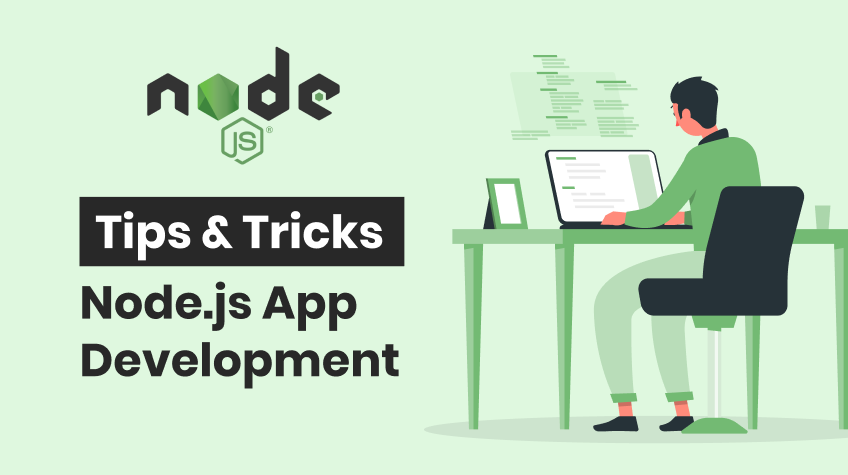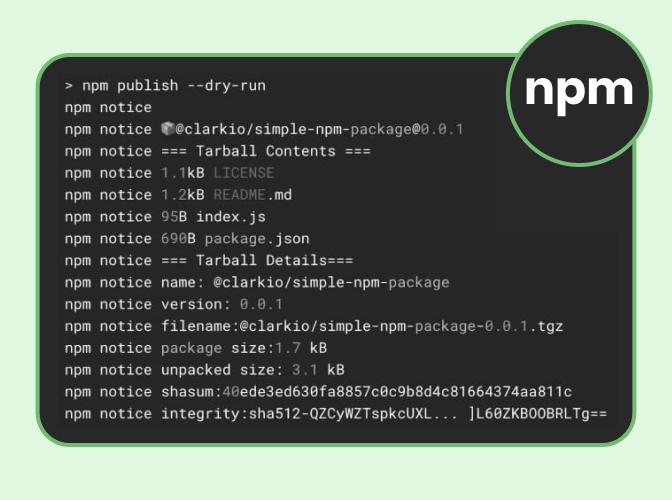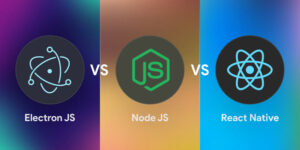
App development is in trend these days, and most people who are passionate about app development wish to work as app developers. However, being an app developer is not a simple thing! Yes, people who work in app development need to carry out a lot of tasks. From gathering requirements to maintenance, they do everything to deploy highly efficient software to the clients. This article helps developers ensure a smooth application development journey. Yes, it provides the best tips and tricks for successful Node js app development.
Before we delve into the tips and tricks to become a successful Node.js app development service provider, we shall first understand what Node JS is. Here we go…
Table of Contents
- What is Node.js?
- Top 15 Tips And Tricks For Node JS Application Development
- Initiate Projects With npm init
- Use Environmental Variables
- Avoid Synchronous Functions
- Handle Inaccuracies
- Restart the App Automatically
- Follow the Best JavaScript Practices
- Cluster The App
- Use GZIP Compression
- Concatenate Numerous JS Files
- Client-Side Rendering
- Application Monitoring
- Code Testing
- Avoid Garbage
- Optimize Performance
- Regularly Update Dependencies
What is Node.js?
Node JS is an open-source environment that creates online chat apps, single-page apps, intensive web applications, video streaming sites, and others. It is a versatile JavaScript runtime environment that is compatible with various operating systems, including Windows, Linux, Unix, macOS, and more.
Node.js operates on the V8 JavaScript engine and executes JavaScript code independently of a web browser. It enables developers to utilize JavaScript to create command-line tools and server-side scripting. Node.js offers many exciting features and plenty of advantages for the users that make it the best alternative for server-side technologies like PHP and Java.
As a developer, having a knack for this popular programming environment is essential in order to build high-scale applications that need to support multiple concurrent requests. Thus, read this article to learn about the significant tricks and stand out from others.
Without further delay, let’s get started!
Top 15 Tips And Tricks For Node JS Application Development
Here are some of the best tips and tricks for Node JS app development. We believe implementing these tips will assist you in further improving your skills and developing a natural talent for it.
1. Initiate Projects With npm init

Use npm to initiate a new Node.js project.
Wondering what is NPM?
Well, it is an ideal method to add couplings or dependencies, and you can use it to browse every Node.js package. Using the popular packages offers numerous benefits, such as reusability, community support, and managing dependencies. Basically, it allows developers to understand the overall project environment. You can include a ton of metadata and a semantic versioning-compliant update of Node.js. And setup.npmrc to ensure that npm install always updates the package .json.
2. Use Environmental Variables
Configuration management deals with the procedure of decoupling the service, code, database, etc., during every phase. It includes development, production, and others. Check the NODE_ENV environment variables and use them in Node.js to develop the values from process.env in your code. Finding the values in process development becomes a breeze by utilizing environmental variables. Adding to this, to maintain code reusability across the project, choose the existing Node.js coding rule.
3. Avoid Synchronous Functions
For successful Node JS app development, it is crucial to avoid Synchronous Functions. Instead, make asynchronous functions a part of the code; turn on the trace, sync, and IO flags that will show a warning while encountering asynchronous APIs. Plus, it is important to simplify the logic flow and test the process. Avoiding synchronous functions can enhance the overall performance of the Node JS application. So, make sure to use this tip when developing the app.
4. Handle Inaccuracies
Deploying high-standard software must be the ultimate goal of every developer, so ensure that you eliminate even a minor inaccuracy. Know that it can have a negative impact on the entire process. However, you can easily handle inaccuracies by providing a catch() handler to eliminate errors effectively.
5. Restart the App Automatically
It is important to establish a condition for restarting the application in order to prevent any potential dependency errors that could cause the application to crash. The process manager can assist you in ensuring that the application recovers from runtime errors or when the server experiences time constraints. Alternatively, the app needs to be restarted in the event of a complete service failure. Make sure to confirm whether the app restarts when encountering specific issues.
6. Follow the Best JavaScript Practices
Developers need to be familiar with the Node.js best practices in JavaScript. As an app developer, you must practice writing asynchronous programming, data types, scope, function arguments, callbacks, and functions and objects in JavaScript.
Beginners can consider enrolling in a JavaScript course. It will help you learn JavaScript in detail while enhancing your knowledge about several other aspects of the programming language. Other than this, you can utilize the Azure functions or application service that offers you serverless code infrastructure. It allows for the creation of responsive HTTP endpoints.
7. Cluster The App
Clustering enables request parallel processing across multiple cores, which enhances the performance and responsiveness of the Node.js application. If you need to run a single process on limited hardware, cluster support can offer you increased flexibility. By clustering the app and keeping track of node execution time limits, you can significantly reduce resource usage.
8. Use GZIP Compression
Using GZIP compression can help you in successful NodeJS app development. GZIP is a compression technology that is used for transferring data quickly through the internet. This software is used for compressing files, and developers can adjust the settings according to the app’s requirements. Well, it is one of the highly preferred tricks that you can use for Node.js app development. GZIP compression compresses the response before sending it to a web browser, which reduces the time lag and latency.
9. Concatenate Numerous JS Files
Optimizing code space is an effective way to enhance the performance of applications. In that instance, concatenating multiple JS files would end up improving the app’s performance. For example, a web browser makes six different HTTP requests for every JavaScript file that cause a blockage and increases the wait time. However, concatenating them will enhance the application’s performance and offer a better user experience.
10. Client-Side Rendering
This is one of the best tips you can follow during NodeJS app development. Client-side JS frameworks such as Backbone JS and Angular JS provide APIs that allow JSON responses to be sent directly to clients, bypassing the need for servers. Client-side rendering reduces latency and saves bandwidth. Plus, it provides a better user experience and richer site interactions through faster loading and quick responses. So, make sure to follow this trick.
In addition, don’t track anything that’s developed using a source control system like git. This could result in redundant bloat and chaos in your git history as you follow the files created for changes.
11. Application Monitoring
Application monitoring is essential for understanding application downtime. Application downtime is a specific timeframe during which the system is not functioning or accessible. It is crucial to receive notifications when your production or service application experiences downtime. Otherwise, how will you identify it? Developers can monitor multiple endpoints, perform functional checks, eliminate flaky checks, configure alert notifications, and keep an eye on testing and staging environments. By following these tips, you can effectively stay alert and identify any unusual behaviours in Node JS applications.
12. Code Testing
Code quality testing is one of the most important steps when developing an app. Whether it is Node JS or any other application, code testing should be carried out throughout the process of app development. Therefore, prioritize code quality testing besides stages of the project, which means whatever your app’s stage could be, start testing.
Another significant trick is using lowercase. Yes, in Node.js, you must use a lowercase filename for everything. For instance, some languages encourage filenames to match class names, like MyClass, but you can write my-class.js in the Node.js language.
13. Avoid Garbage
Node V8 uses an acquisitive and idle garbage collector that has a limit of 1.5GB. More often than not, it waits until it retrieves the lost memory. Given the circumstances, if your memory usage is increasing, it is likely due to the node’s normal idle behaviour rather than a leak. In such a scenario, it’s advised to set up the flags for V8 in your profile to control your app’s trash collector. Trust that following this tip will help you tremendously during Node.js app development.
14. Optimize Performance
Optimizing performance is one of the crucial practices when developing intuitive applications. Using the right tools can help you tremendously. You can use tools to check the status effectively and analyze database queries, CPU-intensive operations, and network requests. Plus, monitoring performance metrics lets the developers identify bottlenecks, inefficient code, and resource-intensive operations in applications.
15. Regularly Update Dependencies
This is one of the best tips for successful Node.js app development. Typically, updates and continuous monitoring are important in any process. Thus, keep your project dependencies up to date and follow these steps to perform them in the right way.
Understand the project dependencies, monitor and evaluate upgrades, avoid simultaneous updates, and upgrade the package. json file, run tests, perform integration checks, resolve compatibility issues, and repeat. Regular review and update of dependencies result in performance improvements in developing Node.js applications.
Top Reasons To Choose Node JS For App Development
There are different reasons available for choosing Node.js over the other server-side languages. However, the first and foremost reason people prefer using NodeJS is that it helps in quick app development and offers a rich ecosystem to build apps. From the developer’s side, its easy learning curve is the most notable advantage. Other than this, there are plenty of reasons available to choose Node JS, such as:
- Enhanced performance
- Easy cross-platform compatibility
- Excellent for MVP development
- Scalable and SEO-friendly
- Real-time development
- Technical support
- Microservices
- Advanced caching and event driving
- Cost-effectiveness
Examples Of Node JS Applications
Node.js is an environment for programming languages and frameworks. Developers execute the JavaScript code in this cross-platform runtime environment. It provides many benefits for the developers, which is why many developers prefer using NodeJS to develop notable apps these days.
Some of the most popular apps that are built on this popular cross-platform runtime environment include,
i. Netflix
Yes, it’s Netflix! Node.js is the better choice for streaming applications. It helps Netflix handle the massive amount of traffic and offers an enhanced user experience. They use React JS for the front end and Node.js for the back end; this approach allows the app to withstand being used even after engaging millions and millions of users simultaneously.
ii. LinkedIn
LinkedIn is one of the top networking apps that can be customized according to the user’s requirements. Well, they switch to the Node JS open-source environment for its exceptional performance and dependability. Initially, they used Ruby in Rails, but after a period of time, they would like to expand it to a more efficient and scalable platform.
iii. Uber
Everyone knows that Uber is an application that allows passengers to enjoy the ride in their cities. Their developer’s team initially coded it in JavaScript; later, they decided to use Node.js to make the applications more responsive. As a result, the company is now able to handle massive traffic and scale quickly.
iv. X (Formally Twitter)
X (Formally Twitter) is yet another platform that is built on NodeJS. Twitter is one of the most popular social media platforms, and it has many users. It has millions of active users that are increasing at a rapid rate each month. Handling such a volume needs the right platform. The company decided to switch from the existing one to Node.js. The Node JS platform is a perfect fit for rapid changes and immediate deployment, so X has relied on Node JS for a long period of time now.
v. Coursera
Coursera is a popular online learning platform that people use for courses, degrees, certificate programs, and tutorials. Node.js is an obvious choice as it makes adding various modules and features to the application a breeze. That’s the reason the Coursera team chose Node JS. It enhances the overall performance and seamlessly organizes a package of educational resources.
In a Word
So, these are the best tips and tricks for successful NodeJS app development. You can use these tips to create an outstanding application with NodeJS. As a developer, you must be aware of trending technologies and strategies. It will help you create stunning apps and elevate the app’s user experience.
In addition, digging deeper into emerging technologies can help you become a well-versed Node.js app developer. Make sure to practice and implement these tips to enhance application performance and deliver the best app to clients!
Thanks for reading!
Hope this article has been insightful for you and will help you easily create a stunning application!






